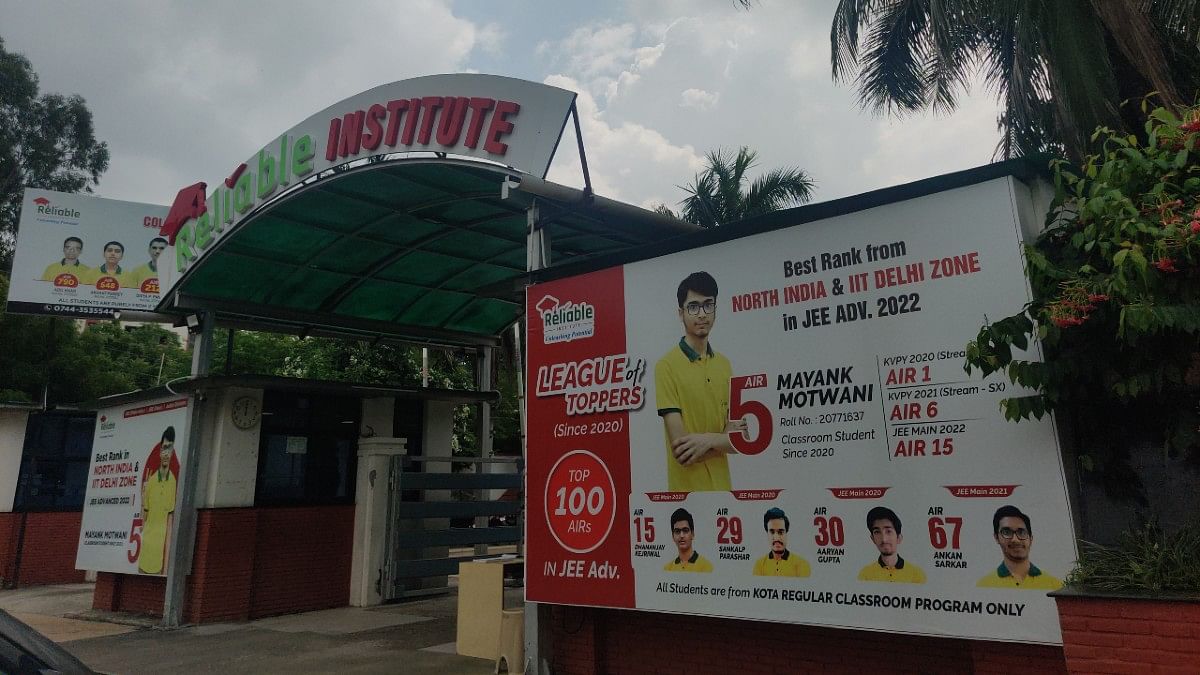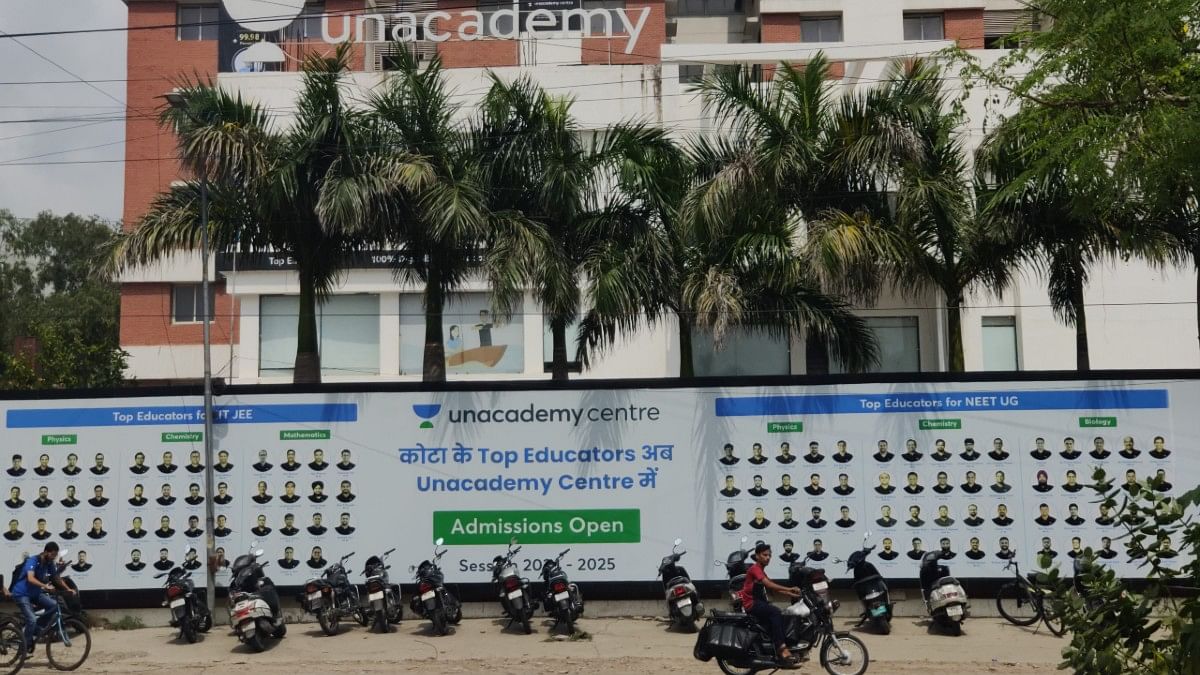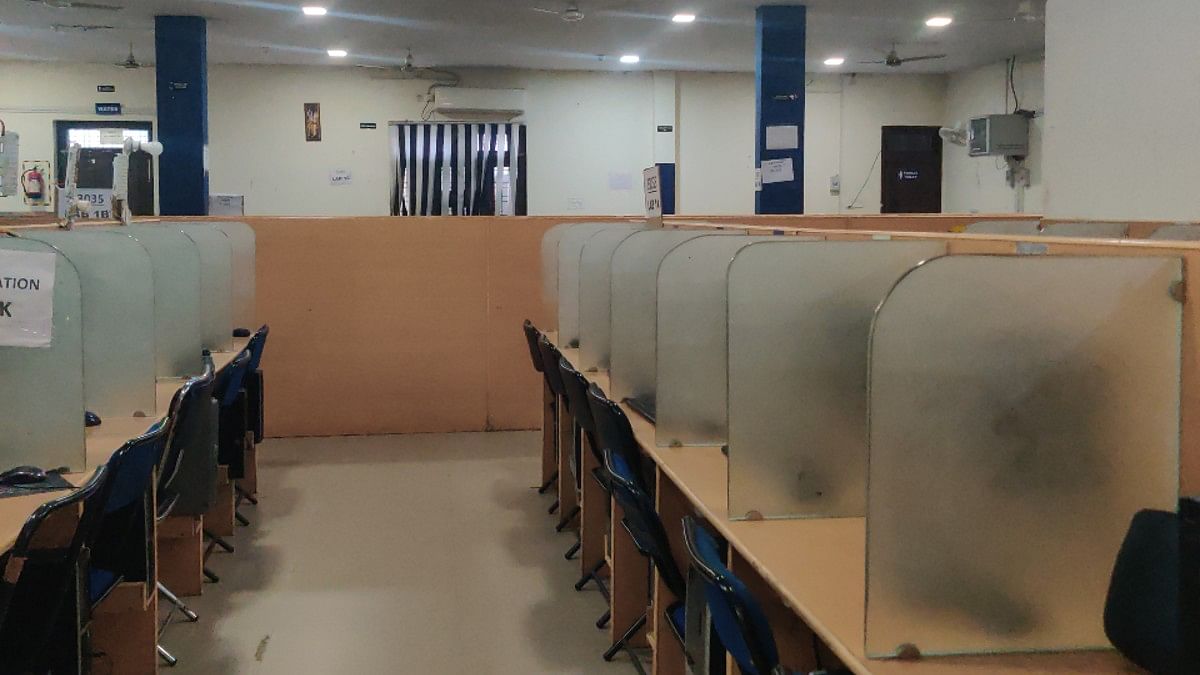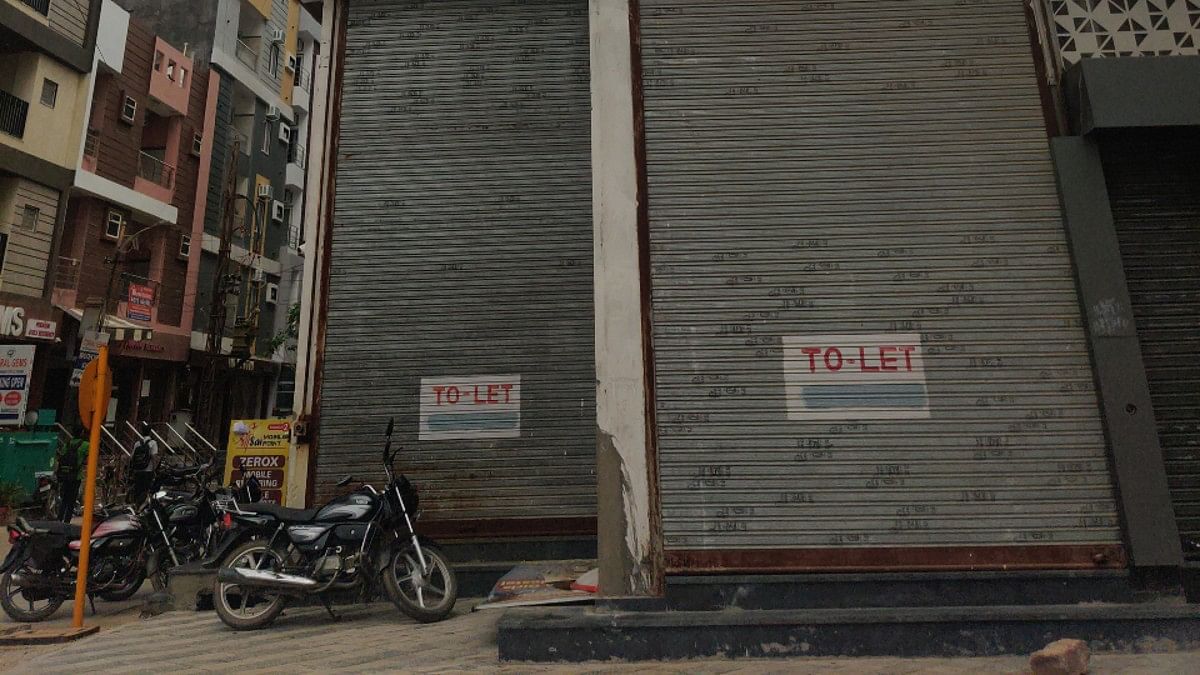“Just last year, I barely had a moment to rest,” recalls Mahavir, with his auto-rickshaw sitting idle in the Coral Park neighbourhood. “I would drive all day without a break. But now I’m not even getting half the customers I used to. My earnings have been cut in half. Our family depends on the students. If they stop coming, how are we supposed to survive?”
A few metres away, 40-year-old Radheshyam, caretaker of a girls’ hostel, is talking anxiously to a broker over the phone. “We’ve got room for 76 girls, and last year, we filled every single room,” he says, his voice heavy with frustration. “But this year? We’ve barely got 24 girls.”
Most hostels and paying guest (PG) accommodations in Coral Park, an area developed 10 km outside of city limits to cater to students, are now operating at half capacity. Some have even shut shop, unable to cope with the drastic drop in takers.
The neighbourhood, with over 300 hostels that can collectively house 20,000-25,000 aspirants, now looks like a ghost town. Streets are lined with “to-let” and “for sale” signs. Hostels fully booked a year ago are now empty, and small shops gather dust.
“The crisis isn’t just here in Coral Park; it’s spread all over Kota. Last year, approximately 2 lakh students were in Kota, it’s been reduced to 1-1.25 lakh now,” claims Sunil Aggarwal, president of the Coral Society, shaking his head in disbelief. “I was expecting to generate Rs 60 lakh this year from our two hostels, but now I’ll be lucky to make even half of that.”
District Collector Ravindra Goswami paints a stark picture of Kota’s changing landscape. He acknowledges that while a unified portal to track student data is still in the works, the economic fallout is already clear. “There has been a sharp 30-40 percent drop in enrollments in coaching centres this year.”
“Tax collected from coaching-related services, in terms of GST, has dropped by 30-40 percent as well. Therefore, we are assuming that the percentage of enrollment has also declined by the same,” he explains.
Stakeholders point to several factors behind the dip in economic activity ranging from commercialisation of education, rise of edtech platforms, emergence of well-known coaching centers in other cities, and the tag of ‘student suicides’.
Also Read: Face of Rajasthan’s coaching hub is changing. Everyone’s rushing to Sikar after NEET success
How Kota became coaching hub
Kota’s journey to becoming India’s most prominent coaching hub began in 1991 with the establishment of Bansal Classes for JEE (Advanced) by educator Vinod Kumar Bansal, affectionately known as ‘Bansal sir’.
Many coaching centres that followed were founded by his former students or colleagues.
Pramod Maheshwari, founder of Career Point and a Physics teacher himself, started teaching in 1993 in his father’s tyre godown. His BTech degree from IIT-Delhi was an instant draw for aspirants. Maheshwari too briefly taught with ‘Bansal sir’.
The turning point came in 1994, when 15 students from Kota’s coaching centres gained admission to various IITs. This number soared to 51 in 1995, with five students ranking in the top 100, says Maheshwari.
In 2000, students from Kota achieved all-India ranks of 1, 2, and 7, as noted by Shishir Mittal, a chemistry teacher known as ‘SM sir’. “Having three students in the top 10 was unprecedented. That was when Kota became a national sensation,” he recalls.

This newfound success led to an influx of students and teachers, resulting in the mushrooming of coaching centre, which in turn, spurred growth of new hostels, PG accommodations, messes, bookstores, and libraries.
Currently, Kota is home to eight major coaching giants: Allen, Resonance, Motion, Unacademy, Physics Wallah, Career Point, Akash, and Sarvottam.
They offer coaching for JEE (Mains), JEE (Advanced) and NEET-UG.
“Quality of content, our systematic approach, and expertise of our teachers were unmatched in the country,” Mittal tells ThePrint. “Our rigorous selection process meant we could admit only around 1,000 to 1,200 students from 15,000 to 20,000 applications.”
Maheshwari adds that a strong bond between students and institutions helped establish Kota as the premier destination for coaching in India; a connection that, in his view, has somewhat diminished over time.
When education takes a backseat
Until 2000, education was the primary focus, and profit merely a byproduct, says Maheshwari, adding that the ground began to shift soon after.
“Faculty members at various coaching centres grew ambitious, opening their own institutions and accepting students without entrance tests, marking a new phase in Kota’s journey. Money started pouring in from all directions. Entrance tests evolved into scholarship exams, allowing students to gain admission to coaching centres regardless of their aptitude,” he says.
Over the years, Kota’s coaching industry and its related businesses have been valued at approximately Rs 6,000 to Rs 10,000 crore, with average cost for enrollment (for medical or engineering) at Rs 1.5 to Rs 2 lakh per year.
Mittal agrees, noting that this enabled new coaching centres to ‘poach’ faculty from older centres, leading to increased commercialization.
Over the past two decades, nearly all coaching institutes have seen teachers switching loyalties overnight for substantial salary increases as high as 50-60 percent.
“Huge influx of students resulted in larger class sizes, causing the personal connection between students and teachers to diminish. The opportunity for individualised attention faded, leaving many students feeling neglected and isolated. Furthermore, as admissions increased, the selection ratio decreased because the number of IIT and medical seats remained limited,” he says.
Mittal explains how those running hostels and paid guest (PG) accommodations saw this surge in demand and “raised prices exorbitantly, making it unaffordable for many parents”.
According to the hostel association in Kota, the city has over 4,000 hostels offering an estimated 1,80,000 rooms, along with 60,000 rooms in PG accommodations. Additionally, there are 8,000 to 10,000 studio apartments. These accommodations are located in neighbourhoods like Jawahar Nagar, Indira Nagar, Rajiv Gandhi Nagar, and Landmark City.
The average hostel fee in Kota ranges from Rs 8,000 to Rs 12,000 per month. Most rooms are about 100 square feet and come equipped with a single bed, a table and chair, an almirah, and an attached bathroom.
On the academic side, poaching extended beyond teachers; even students were actively targeted by rival coaching centres.
“The focus shifted to a select group of high-performing students, who were offered free coaching, accommodation, and exclusive mentorship as an investment for the institute, while others paid substantial fees for the same services. This segregation began to create dissatisfaction among the remaining students,” says a former senior faculty member from Allen, who did not wish to be named.
Adding, “All these factors combined created a sense of pressure and dissatisfaction among many students, leading some to take the extreme step of ending their own lives after experiencing failure.”
Kota has shifted its focus away from average students, according to a former Physics teacher at Allen.
“We often see large billboards showcasing toppers and their ranks, but has any coaching centre ever published the percentage of students selected versus those enrolled? No. The system has evolved to prioritise only the top performers,” the teacher told ThePrint.
Also Read: ‘No abnormality’ in NEET results, but analysis shows coaching hubs like Kota, Sikar bred more toppers
Pandemic & rise of online education
After suffering a complete two-year shutdown due to the COVID-19 pandemic, Kota experienced an unprecedented surge in enrollments in 2022, with over 2,00,000 students arriving in the city in southeastern Rajasthan from across the country that year.
Teachers note that during the pandemic, students were assessed quite leniently in board exams, leading to a significant influx of them to Kota in hopes of securing seats in IITs or medical schools.
“It created a false sense of hope among both parents and students, making them believe that their child could succeed in the entrance exam even without the necessary aptitude. Moreover, students were tired of being stuck at home and studying online; they wanted to attend physical classes. As a result, enrollments increased by 40-50 percent in 2022,” says Shiv Pratap Raghuwanshi, HoD (Chemistry) at Resonance.
According to CBSE data, overall pass percentage surged by 9.3 percentage points in 2022 compared to the pre-pandemic year of 2019. Additionally, the number of students scoring 90 and 95 percent marks also rose significantly.
However, Raghuwanshi points out that it was unrealistic to expect the same influx of students each year. “Maintaining that pace is challenging. We can view this as a correction rather than a decline. When we compare it to enrollment rates before the pandemic, the drop isn’t significant.”
But, the pandemic-induced lockdown gave rise to a parallel system in India: online education.
Teachers believe emergence of online education platforms too impacted the traditional coaching model. Various platforms, including Physics Wallah and Unacademy, along with many faculty members, began producing online lessons that were either free or available at a nominal cost.

“Many students taking a gap year are choosing to study online instead of attending traditional coaching. After spending two years in classes 11 and 12 and covering the syllabus, they feel they can effectively revise and enhance their understanding using online resources. This year, especially, we’ve noticed a decline in droppers attending in-person classes,” says a senior Physics teacher at Motion Education, who did not wish to be named.
The teacher also attributed this year’s delay in NEET-UG results to the paper leak controversy. “About 60 percent of our students are gap-year candidates preparing for competitive exams. Many felt discouraged by the issues they faced in the NEET-UG exam this year and are hesitant to try again. This has contributed to a decrease in student enrollment this year.”
Students new to Kota say they had different expectations before coming to the city. Anuj Singh, who came from Uttar Pradesh’s Kannauj with a dream to get into an IIT, tells ThePrint, “I have been told that given the number of students, there was no space in hostels last year but this time it’s not like that. Many rooms in my hostel are lying vacant.”
Naveen Mittal, president of Kota’s Hostel Association, mentions that some new hostels constructed this year were forced to shut down. “The rate of real estate has decreased by at least 25 percent,” he adds.
‘Kota: suicide city’
Sitting in his office in Rajeev Nagar, Naveen Mittal scoffs about the media unfairly “defaming” Kota and depicting it as a city where all students face unnecessary “pressure.”
“If you look at NCRB data and figures from other organisations, you’ll see Kota isn’t even among the top 50 cities for student suicides. Yet, negative portrayal of our city over the past two years has created fear among parents, making them reluctant to send their children here,” he says.
Adding, “You tell me, where is there no pressure? A cricketer performing in front of thousands experiences pressure too. It’s not exclusive to Kota.”
According to official data, 28 students died by suicide in Kota last year, and there have already been 13 reported cases this year. The spate of suicides sparked a national outcry, leading to various initiatives aimed at helping students manage pressure and stress. These include a 24/7 helpline, access to counseling, declaring Sundays as “Fundays”, and the installation of spring devices on ceiling fans, dubbed ‘anti-suicide’ devices.
However, to rebuild the confidence of students and parents, District Magistrate Goswami highlights that the administration is actively combating misinformation about Kota being a “suicide city”.
“This year, we implemented gatekeeper training, which I believe is the largest initiative of its kind for support workers in India. Hostel association also informed me about this. All involved are receiving ongoing training, including refresher courses I’ve initiated as part of a collective effort.”
Goswami also regularly meets with students through the “Dinner with Collector” initiative.
“I directly engage with students. So far, I have reached out to around 25,000 students in coaching centres, and we plan to continue these interactions. My office also visits coaching centres to meet students personally,” he tells ThePrint, adding that coaching centres and hostel owners too have agreed to lower their rates.
Also Read: Kota was once a prosperous industrial hub. Now it has just 1 factory left — exam coaching
Emergence of ‘closer to home’ coaching centres
Another significant factor contributing to the declining trend of enrollments in Kota is the ‘decentralisation’ of coaching centres over the past two years. Officials from coaching centres and the district administration note that these “closer to home” options emerged when parents began to lose confidence in sending their children to Kota.
Allen has opened new centres in at least 60 cities across India, including Patna, Rohtak, Latur, Jodhpur, and Durgapur. Unacademy too has established over 61 centres, and Physics Wallah has opened centres in cities across Bihar, Uttar Pradesh, Kolkata, and Gujarat.
“The cost of living is significantly lower for students who stay at home and attend coaching compared to those living in hostels or PGs in Kota. Additionally, being closer to their parents is ideal for families, especially after the troubling number of student suicides reported here in Kota last year,” says Maheshwari from Career Point.
However, teachers believe these new centres will not be able to match the standards of Kota. “The new centres employ inexperienced faculty members. They cannot meet the high standards we have maintained in Kota. Once the students at these new centres realise this, they will eventually return here,” says Raghuwanshi from Resonance.
Ripple effect
In Kota, nearly every aspect of life revolves around its thriving coaching industry, and right now, the ripple effects of its decline are being felt far and wide. Even teachers are facing the fallout. At various coaching centres, whispers of layoffs and salary cuts have become all too common.
“With the number of students dwindling, many teachers have lost their jobs, and most faculty members have experienced salary reductions this year,” shares a senior faculty member from Allen, who preferred to remain anonymous. The reported cuts range from 20 to 30 percent. Despite requests for comment, Allen did not respond.
According to reports from June this year, Rajesh Maheshwari from Allen had acknowledged a staggering 31 percent drop in enrollments at their Kota centres.
Owners and workers of the nearly 500 messes scattered throughout Kota are also bracing for an uncertain future. These messes provide affordable meals, typically priced between Rs 75 and Rs 100.
B.R. Bishnoi, who operates Shri Lakshmi Mess in Jawahar Nagar and Parijat Colony, laments, “We have at least 300 fewer students than last year. We’re barely managing amid rising inflation.” His worry is palpable as he stares at the nearly empty tables.
In the nearby Vigyan Nagar neighbourhood, Lakshmi, a cook at a local mess, reflects on the toll this decline has taken on her colleagues.
“Two of my co-workers have already been let go. Many cooks and helpers across different messes are losing their jobs because of the dwindling student numbers. We’re all hoping for a better influx of students next year so we can keep our livelihoods,” she says.
Darsh Manglani, who runs the now-deserted Tirupati Stationery, too expresses his frustration. “Our sales have declined by 50 percent this year. We’ve been operating this shop since 2009, but we’ve never faced such losses. If students don’t return next year, many stationery shops like ours near the coaching centres might have to close down.”

Another story worth telling is that of digital desks scattered throughout Kota.
Just a year ago, coaching centres would scramble to book slots for their weekly practice tests, but the scene has changed drastically.
Ramgopal, who works at a digital desk in Kota’s industrial area, explains, “We have a capacity for 900 students, but now we rarely see more than 400 or 500 on a good day. We used to conduct around 20 exams each month, but now it’s only about 8 to 10. It’s disheartening.”

Back at his mess, Bishnoi, who has 300 fewer students using his services this year, goes from table to table to see if they enjoyed the food that day.
“We aim to treat these kids like our own. I will never compromise on quality, even if it means facing losses. We got through the pandemic, and will overcome this slowdown as well. But, if this situation lasts more than two years, we may need to consider other options. For now, it’s wait-and-watch,” he says, underlining Kota’s dwindling fortunes.
(Edited by Amrtansh Arora)
Also Read: School education secy hits out at ‘Kota model, coaching pressure’ — ‘Where is joyful learning?’

